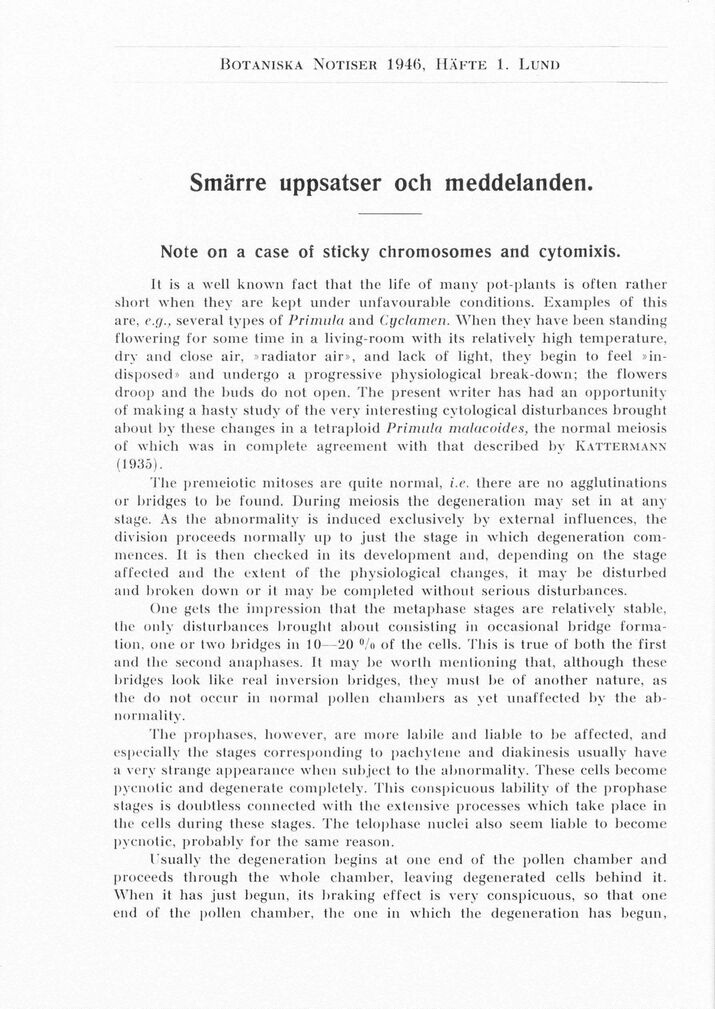
Full resolution (JPEG) - On this page / på denna sida - Sidor ...

<< prev. page << föreg. sida << >> nästa sida >> next page >>
Below is the raw OCR text
from the above scanned image.
Do you see an error? Proofread the page now!
Här nedan syns maskintolkade texten från faksimilbilden ovan.
Ser du något fel? Korrekturläs sidan nu!
This page has never been proofread. / Denna sida har aldrig korrekturlästs.
Botaniska Notiser 1946, Häkte 1. Lund
Smärre uppsatser och meddelanden.
Note ön a case of sticky chromosomes and cytomixis.
It is a well known faet that the life of many pot-plants is often rather
short when they are ke|)t under unfavourable conditions. Examples of this
are, e.g., several types of Pri mill a and Cyclamen. When they have heen standing
flowering for sonie time in a living-room with ils relativelv high temperature,
dry and close air, »radiator air», and lack of light, they begin to feel
»in-disposed» and undergo a progressive physiological break-down; the flowers
droop and the buds do not open. The present writer bas had an opportunity
of making a hasty study of the verv interesting cvtological disturbances brought
about by these changes in a tetraploid Primulu malacoides, the normal meiosis
of which was in completë agreement with that described by Kattermann
(1935).
The premeiotic miloses are quite normal, i.e. there are no agglutinations
or bridges to be found. Düring meiosis the degeneration may set in at any
sluge. As the abnormality is induced exclusively by external influences, ttie
division proceeds normally up to just the stage in which degeneration
com-mences. It is then checked in its development and, depending ön the stage
affecled and the cxlent of the physiological changes, it may be disturbed
and bruken down or il may be completed without serious disturbances.
One gels the impression that the metaphase stages are relativelv ståhle,
the onlv disturbances brought about consisting in occasional bridge
formation. one or I wo bridges in 10–20 °/o of the cells. This is true of both the first
and the second anaphases. It may be worth meidioning that, although these
bridges look like real inversion bridges, they musl be of another nature, as
the do not occur in normal pollen Chambers as vet unaffected by the
abnormality.
The prophases, however, are möre labile and liablc to be affected, and
especiallv the stages corresponding lo pachvlene and diakinesis usually have
a verv stränge appearance when subjecl to the abnormality. These cells become
pycnotic and degenerate complelely. This conspicuous lability of the prophase
stages is doubtless connected with the extensive processes which take place in
the cells during lliese stages. The telophase nuclei also seem liabte to become
pycnotic, probably for the same reason.
t sually the degeneration begins al one end of the pollen Chamber and
proceeds through the whole Chamber, leaving degenerated cells behind it.
When it tias just begun, its braking effect is verv conspicuous, so that one
end of the pollen Chamber, the one in which the degeneration bas begun,
<< prev. page << föreg. sida << >> nästa sida >> next page >>